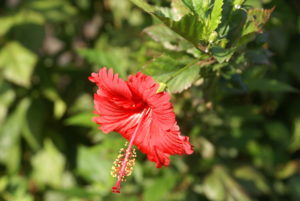What Thrived in the Drought
2016-2017 was an epic year for the Indian state of Tamil Nadu. We faced the worst drought in 140 years.
So all around us, drilling for water upto a depth of even 1100 feet has become the norm.
Our motor suspended at 500 feet could not pump water any more because water tends to flow towards neighbors deep borewells.
We lost 25 out of 38 coconut trees, all the exotic trees like nutmeg, tomatillos, cloves and many fruit trees..
And banana crop as well as turmeric crop succumbed entirely. Looking at clouds with longing has become an every day affair 🙂
And it was a time to question everything.
Is our climate zone changing from tropical to semi arid?
If rain fed farming is the only way out, where is the rain?
If the pattern is going to be floods one year and droughts for the next 3 years, how do we store all the flood water to use for the non rainy day?
Can we even find or build such a large container to store the flood?
Along with questions, it was time to step up our water saving and recharge efforts – just in case it rains!
And also, it is time to reflect what species not just withstood the drought but actually thrrived under thsese seemingly harsh circumstances. And amplify those patterns.
Here is a list of perennials that tug at our hearts by not just withstanding the drought but also by thriving. They seem to have found their own source of nourishment.


Fruits
Custard Apple
Surinam Cherry
Country mango
Veggies
White Brinjal
Moringa / Drum stick
Sundakkai / Solanum torvum
Greens
Agathi / Sesbania
Moringa
Ceylon greens
Insulin keerai / Costus Pictus
Red Basale / Basella
Gonkura / Rosella
Medicinal Plants
Adathoda
Thoodhuvalai / Solanum Trilobatum
Nochi / Vitex Negundo
Tulsi
Spices
All Spice
Basil (indian)
Lemon grass
Green Manure Trees
Gliricidia
Mulberry


Flowers
All flowering trees and among the bushes,
Hibiscus
Nandhiavattai / Moon Beam
Jasmine
And we hope this list grows with years.


Hi Ragu,
The situation was pretty similar with your neighbours from the north – Shridhar/Hari’s farm near Malavalli. Rain was totally absent in 2016 and even in June/July of 2017. Unlike your farm that has mature plants, most of our plants are just 2 years old. I didn’t see many deaths (some guava and one pomegranate died) but I could see they were all under stress. Most borewells around us run dry. We don’t even have a borewell at our place… we are relying on rain and water coming from a rivulet called Shimsa nearby through a gov. scheme (it”s called lift irrigation). That stream ran dry this year – it was never dry in the last 7 years I have been here. So our plants were pretty much at the mercy of nature. I am no longer optimistic about farming.
Like you noted, even I noted that few plants survived and some thrived as well. Among the fruit trees, mangoes and Chiku did well. Neem trees seemed to be thriving in the heat and dry weather.
This august we finally saw the rains that we expect from a monsoon – 13 CMs in 2 days on 15th and 16th Aug!
I will see if I can get some Surinam cherry at my farm 🙂
regards
Hi, thanks for documenting this. Hope you made the most of the epic (at least relatively speaking) rains that followed the epic drought.
I am surprised that Sundaikkai, Agathi, Gongura and Tulsi made it to this list. Keeping in mind that soil and location of the plants must be different in my case, sundaikkai has been the first plant to wilt. Agathi had a regular population of caterpillars which ate the growing tips, I gave up hand picking after a while. Gongura grew to half the height it would grow normally before it bolted and though Tulsi (purplish leaves and stem) didn’t thrive, it survived the heat better than the other plants of its size.
I would like to know if the plants in your list somehow got more attention — a bit of shade, a bit more water or did they get the resources that were meant for the other plants that died… etc.
Hi Gokul, as long as a slice of the eco system survives, all of the eco system comes back. With renewed intelligence
The Sundakkai Tulasi and Gonkura did get some shade. Agathis were trees so no surprise there.
The rains were not that epic in our region but good enough to give us a break. At this point, we are grateful for any rain we get.
We tried to make good use of the rains by storing water, planting about 200 fruit saplings and 6 coconut saplings and expanding veggie beds for home BN use.
AWishing all good things to you and the farm